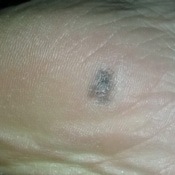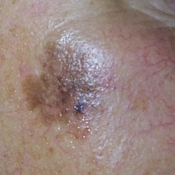What is melanoma skin cancer, what causes it, and what does it look like?
Melanoma skin cancer is a serious type of skin cancer that develops in the cells that produce melanin, the pigment that gives your skin its color. Understanding its causes and recognizing its appearance are crucial for early detection and effective treatment.
Table of Content:
What is melanoma? |
Melanoma risk factors |
Melanoma causes: Who is at risk? |
Melanoma facts |
What does melanoma look like?
Our commitment to producing high-quality content:
The information presented in this article is based on scientific research and the professional advice of our Content Medical Reviewers, who are experts in the field of Dermatology. How we write our content →
What Is Melanoma Skin Cancer?
Melanoma (sometimes known as malignant melanoma) is a form of skin cancer, arising from cells within the skin called melanocytes.
These melanocytes are normally responsible for producing melanin, a dark coloured pigment which is responsible for giving our skin its colour and the formation of moles on the skin.
As with other forms of skin cancer, melanomas are linked to exposure to UV light. It is thought that your genetics may also have a role in whether you develop melanoma – and there does appear to be a higher risk of skin cancers if other family members have also had skin cancer.
Some studies also suggest that those with many moles or pale skin that burns easily in the sun are also at an increased risk of melanoma.
In its initial stages, a melanoma begins by a concentrated overgrowth of melanocytes which start to accumulate. After this process has started, the melanocytes begin to spread to other layers of skin, and if undetected or ignored, can spread to other parts of the body (known as metastatic melanoma). After being diagnosed, the melanoma will be staged depending on the extent of its growth.
Minimising your exposure to UV light is one simple way to reduce your risk of skin cancer. This can be by reducing your amount of time out in the sun as well as using a high SPF (sun protection factor) sunscreen.
Melanoma Risk Factors and Causes
Melanoma is a type of skin cancer that can affect anybody. It is the most dangerous type of skin cancer and there are over 3 million people currently living with the condition. More than a quarter of a million new cases are diagnosed each year across the world.
Statistics show that there are a range of melanoma risk factors that affect the likelihood of any particular person developing the condition.
Some of these risk factors are innate but some others can be modified in order to reduce the chances of suffering the condition in the first place.
Statistics also clearly show that early melanoma detection vastly improves outcomes including survival rates.
A good knowledge of the main skin cancer risk factors including some specific melanoma risk factors can help patients determine if they are at increased risk and require extra precautions in the sun and to check their skin more often.
Melanoma Causes: Who Is at Risk for Melanoma?
Innate melanoma risk factors (not modifiable)
Statistics show that men are at a higher risk of melanoma than women with twice as many men dying from the condition. Increasing age is also a factor as the rates of melanoma increase as we get older. However, there are increasing numbers of young patients under 30 being diagnosed with the condition.
Genetic characteristics are one of the main malignant melanoma causes and the following traits are all melanoma risk factors:
- Fair skin color
- Blonde and red hair colour
- Large number of moles
- Many atypical moles
- Many freckles
- Having a family member with melanoma
Modifiable melanoma risk factors
The innate melanoma risk factors above are out of our control. The main modifiable risk factor is limiting your exposure to ultraviolet (UV) rays.
The following activities expose your skin to higher levels of UV rays and therefore put you at a higher risk:
- Tanning in the sun or indoor tanning (sunbeds)
- Working outdoors e.g. in farming or construction
- Living in a country where the sun is strong
- Not wearing a hat or clothing to protect against the sun
- Skipping sunscreen or using only a little
Reaching the point of sunburn is a clear indicator that you are being exposed to too much UV light. 90 percent of non-melanoma skin cancers come from UV exposure.
Being diagnosed with other, less serious forms of skin cancer does not automatically mean you will get melanoma. It does however indicate a higher level of risk.
Melanoma is highly treatable if caught early. If you have genetic risk factors or have the higher levels of exposure to UV rays mentioned, it is vital to closely monitor your skin.
Am I at Risk for Melanoma?
Taking into account the melanoma risk factors mentioned, there have been some tools developed to help individuals determine their own level of risk.
At this time, these melanoma risk calculators are country specific with the following tools available:
It is important to use these tools as indicators. They are specific to the risk of melanoma in that country. The risk of other non-melanoma skin cancers is much higher.
Patients with low melanoma skin cancer risk scores can still develop the disease and it is important for all of us to check our skin regularly.
Learn more about how to recognize possible signs and symptoms of melanoma.
In addition, take a look at this Melanoma image guide that will walk you through different photos showing the melanoma signs and warning changes on your skin you should be looking for.
We also recommend you to see how other skin cancer types look like and read more about symptoms of basal cell carcinoma and squamous cell carcinoma.
Those that are at higher risk, based on these risk calculators, or because of the risk factors mentioned above, should visit their local GP or dermatologist if they notice changes in their skin.
A few minutes with a doctor to assess your skin could prevent years of treatment for skin cancer.
What Does Melanoma Look Like?
There are several different types of melanoma skin cancer, and its appearance can vary depending on its type.
However, the most typical melanoma will appear dark and uneven in colour, they will look asymmetrical in shape and their outline (or border) will be irregular (it may look blurred or ragged) and they will likely have shown some changes in the proceeding few weeks or months.
70% of melanomas start out as new marks on the skin rather than as changes to existing moles. This means it’s also important to watch out for new moles, as well as monitoring existing normal moles and any abnormal atypical mole you may have. Read our full guide on how to spot melanoma on your body.
Moles which increase in size, shape or colour, or have associated symptoms such as itching, bleeding or breaks in the skin, all need to be assessed by a doctor.
A quick and easy tool to monitor any moles is to think “ABCDE” – Asymmetry, Border (is it regularly or irregularly shaped), Colour, Diameter, Evolving (how else has it changed).

Melanoma skin cancer images supplied by DermNet NZ.
Another effective tool is what’s known as the “Strike Factor” or “Ugly Duckling Sign”. Each person has common characteristics to their moles, and when looking at the skin as a whole, these moles appear to be all very similar.
However, if there are any marks on the skin which are not normal for you, and appear different (like an ugly duckling), you should get these looked at.


If you want to know more about what signs on your skin to look for, take a look at these pictures of melanoma with explanations of the ABCDE of melanoma.
Where Does Skin Cancer Start on the Body?
Basal cell skin cancers and squamous cell skin cancers are the most common types of skin cancer and most likely to appear in sun-exposed areas. These skin cancer images can give you a clue of what the most common types of skin cancer might look like.
Where Does Melanoma Usually Start?
There are sites which are more commonly affected and it is particularly important to monitor changes in these areas.
For women, the legs are the most commonly affected site whereas men are most commonly affected on their backs. A quarter of melanomas start in existing moles hence the need to closely monitor any moles that you have – especially abnormal, irregular and atypical moles.
See this extensive melanoma photo gallery for examples of how melanoma can look like but remember to see your doctor if you are in doubt.
How Quickly Can Melanoma Appear?
Melanoma can slowly develop over years or can arise from a sudden change in the skin or a previous mole. The time for any changes to become obvious will vary depending on the exact site and surrounding skin.
It is recommended to perform skin self-exams on a regular basis in order to identify any suspicious changes to the skin which could be a warning sign of skin cancer.
Read more about melanoma signs and symptoms in our guide on the early signs of melanoma.
Melanoma Facts
Melanoma is a relatively common type of cancer in the United States. According to the American Cancer Society’s projections for 2024:
- Approximately 100,640 new cases of melanoma will be diagnosed, with about 59,170 in men and 41,470 in women.
- Around 8,290 people are expected to die from melanoma, including about 5,430 men and 2,860 women.
The incidence of melanoma varies with age and gender. For individuals under 50, the rates have remained stable in women and have decreased by about 1% annually in men since the early 2000s. For those aged 50 and older, the rates have increased in women by about 3% each year but have remained stable in men.
Melanoma death rates saw a significant decline from 2013 to 2017, decreasing by approximately 6% to 7% annually, largely due to advancements in treatment.



